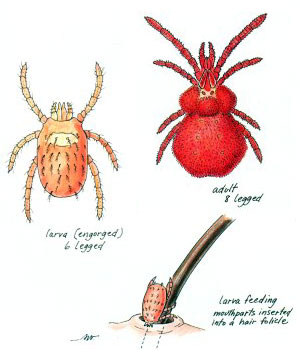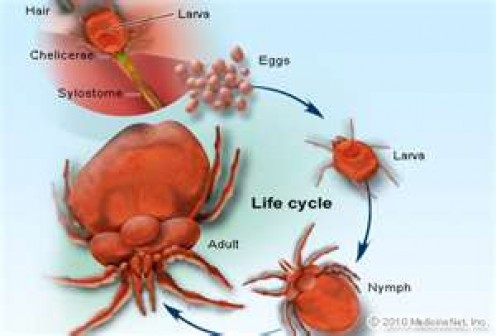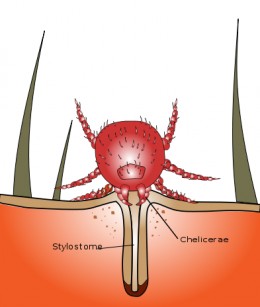It is not the adult stage of the Harvest mite which causes the problems, but the six-legged larval stage which can send people and animals crazy scratching which then leads on to secondary infection. These are white to orange red in colour, that is before they have a good feed on you...and very small something like 1/100 of an inch, just about visible. To understand what is going on we need to know a bit of biology:
Lifecycle - Adult harvest mite overwinter near or slightly below the soil and in other protected places. Females become active in the spring and lay up to 15 eggs per day in vegetation when soil temperatures are 60°F. The larvae congregate in groups on small clods of earth, in matted vegetation and even on low bushes and plants, where they have more access to a prospective host. The first active stage in the life of the harvest mite is the six-legged larva and this is the only stage to attack warm-blooded animals. A drawing (courtesy of Ohio State University) shows the difference between the adult and the larvae.
The life cycle is about 50 to 70 days, with adult females living up to one year and producing offspring during this time. Multiple generations occur in warmer climates, whereas only two to three develop each season in some northern areas/countries. They are active only during the day and their movements appear to be controlled chiefly by the weather, aren't we all, they are most active when it is dry and sunny and least active when the day is cold and wet, as is the case with most insects. When the larvae come into contact with any warm-blooded animal (dogs are particularly susceptible), they swarm onto it and wander in search of a place to attach themselves. Infestation in human beings generally occurs by way of the ankles when walking in areas where the mite is common; sitting or lying on infested ground offers even better opportunities to the mite. The thickness of the skin is probably the most important factor because the harvest mite feeds by thrusting its small hooked chelicerae (fangs) into the surface layers of the skin. Where the skin is unusually thick they attach with difficulty and may be brushed off by the movements of the host. Young harvest mite larvae attach themselves to the skin of people, domestic animals, wild animals (including reptiles), poultry and birds. The preferred feeding locations on people are parts of the body where clothing fits tightly over the skin such as around the belt line, waistline, under girdles and under socks, or where the flesh is thin, tender or wrinkled such as the ankles, in the armpits, back of the knees, in front of the elbow, or in the groin, especially around hair follicles (see below again courtesy of Ohio State).
The insertion of the small fangs into the skin is painless, and is merely intended to puncture the skin so that the feeding process can begin. Harvest mite larvae do not burrow into the skin, nor suck blood. They pierce the skin and inject into the host a salivary secretion containing powerful, digestive enzymes that break down skin cells that are ingested (tissues become liquefied and sucked up). Also, this digestive fluid causes surrounding tissues to harden, forming a straw-like feeding tube of hardened flesh (stylostome) from which further, partially-digested skin cells may be sucked out. After a larva is fully fed in four days, it drops from the host, leaving a red welt with a white, hard central area on the skin that itches severely and may later develop into dermatitis. Any welts, swelling, itching, or fever will usually develop three to six hours after exposure and may continue a week or longer. If nothing is done to relieve itching, symptoms may continue a week or more. Scratching a bite may break the skin, resulting in secondary infections. However, harvest mites are not known to transmit any disease in this country. Once the larva has finished feeding it drops to the ground to complete its lifecycle. It descends into the soil and, after a period of five or six weeks, changes into an eight-legged nymph. This stage is sexually immature like the larva, but it resembles far more closely the adult male or female into which it eventually develops. Both the nymph and the adult live in the soil and feed on plant juices or small insects. They are never parasitic. They prefer moist conditions (as do all mites as otherwise they would desiccate) and are especially numerous in the vicinity of rabbit warrens. Thus the lifecycle of the harvest mite is completed. The eggs laid by the adult in the spring and summer hatch into the six-legged harvest mites which are most abundant in late summer and autumn. These, after they have fed on warm-blooded animals, develop through the nymph stage to the adult. Distribution - The harvest mite is widely distributed in the British Isles and is particularly abundant on chalk downs. The geological origin of the soil and the climate does not affect its abundance. Heavy infestations, however, are often found to be sharply localised; a heavy infestation may occur in the gardens of one or two houses in a village which is otherwise free from the pest. They may also be found in town gardens and parks...Very common around blackberry bushes, woods, fields Control MeasuresSkin Care - After returning from a chigger/harvest mite-infested area, launder the field clothes in soapy, hot water (125°F.) for about half an hour (this applies to any insect infestation, washing clothes on cool wash does not work, so if your Amani jacket....well you know). Infested clothes should not be worn again until they are properly laundered and/or exposed to hot sunshine. Unlaundered clothes or those laundered in cool water will contain the biting chiggers to again reinfest your skin. As soon as possible, take a good hot bath or shower and soap repeatedly. The chiggers may be dislodged, but you will still have the stylostomes, causing the severe itch. Scratching deep to remove stylostomes can cause secondary infections. For temporary relief of itching, apply ointments of benzocaine, hydrocortisone, calamine lotion, or others recommended by your pharmacist or medical doctor. Some use Vaseline, cold cream, baby oil, or fingernail polish. (The sooner the treatment, the better the results.) Prevention - Mowing of briars, weeds, and thick vegetation and close clipping of lawns, to eliminate shade and moisture, will reduce harvest mite larvae populations, and permit sunlight and air to circulate freely. Harvest mite larvae can penetrate many types of clothing, but high boots and trousers of tightly woven fabric tucked into stockings or boots help deter them. Before going into an area where harvest mite larvae may be present, protect yourself by using a repellent or permethrin available at many chemists or hardware stores. Deet-based repellents are effective for only a few hours, whereas permethrin-based repellents are for use only on clothing and effective for several days. Apply the repellent to both the skin and clothing, especially on hands, arms, or legs, if uncovered, and to clothing openings at cuffs, neck, waistband, and upper edges of socks. Follow label directions since repellents may damage plastics, nail polish, and painted or varnished surfaces. Do not use indiscriminately as severe human allergies can develop. Keep moving since the worst harvest mite infestations occur when sitting or laying down in a sunny spot at midday with temperatures above 60°F. If possible, stick to roads and trails. |


